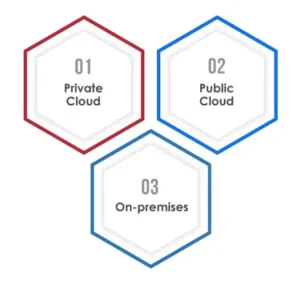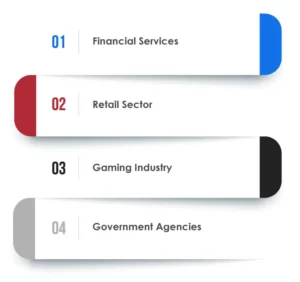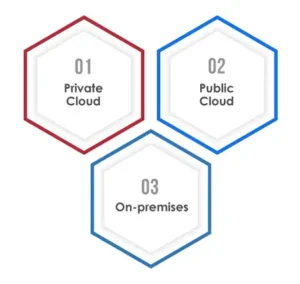- Understanding Hybrid Cloud: Key Concepts and How It Works
- Key Components of Hybrid Cloud
- Top Business Benefits of a Hybrid Cloud Platform
- Hybrid Cloud Real-World Applications
- Are There Any Regulatory or Security Issues with the Hybrid Cloud Model?
- How can Tx assist with Cloud Implementation?
- Summary
Organizations are highly pressured to innovate to remain competitive in this digital age. Enter hybrid cloud, a transformative mix of public and private cloud environments. It is rapidly optimizing IT infrastructure for businesses that want to remain agile and optimize their efficiency. According to a survey, the global hybrid cloud market is projected to reach $558.6 billion by 2032. It will allow organizations to seamlessly move data and apps between on-premises data centers and public/private cloud services, allowing them to customize their IT strategies to meet operational and business goals.
In this blog, we will explore the hybrid cloud’s components and how its real-world applications further shape the future of IT infrastructure. We will also discuss the business benefits of hybrid multi-cloud platforms and whether there are any security or regulatory issues in managing them.
Understanding Hybrid Cloud: Key Concepts and How It Works

A hybrid cloud or cloud hybrid is a computing environment that merges on-premises infrastructure with public and private clouds. It allows businesses to create a single, cost-effective cloud infrastructure. They can easily share applications and data between on-prem, public, and private clouds. Organizations sometimes utilize multi-cloud configurations, using multiple public clouds and on-premises data centers. They can also leverage the latest tech innovations, like AI, IoT, edge computing, etc., to stay competitive.
A hybrid cloud environment varies according to business objectives, but they all share a pool of computing resources mentioned below:
Private Cloud
All resources remain isolated and operate exclusively in this cloud computing environment. It combines various computing features with the control and security of on-premises IT infrastructure. Organizations dealing with sensitive data and compliance require private cloud configurations.
Public Cloud
Hosted by a third-party cloud service provider (AWS, IBM Cloud, Google Cloud, MS Azure, etc.), the public cloud supports virtual machines to complete enterprise-level dev and infra platforms over the public internet. It works on a pay-as-you-go pricing model. The public cloud has four major service offerings: SaaS, PaaS, IaaS, and serverless computing.
On-premises
A traditional computing environment in which organizations handle their computing resources (software, hardware, data centers, etc.) at their personally owned physical location.
Key Components of Hybrid Cloud

Hybrid cloud works by integrating public and private cloud architectures with on-premises infrastructure. This unified computing approach allows businesses to leverage the benefits of multiple environments while supporting connectivity, automation, and resource pooling. Let’s take a quick look at the core components of a hybrid cloud:
Hybrid Cloud Resources
For the hybrid cloud to work, one needs resources from public and private cloud providers, such as on-premises data centers and private cloud functionalities.
Interconnectivity Between Cloud Environments
Technologies like VPNs, WANs, and APIs are significant to the robust networking capabilities of the hybrid cloud. It relies on public internet services such as AWS Direct Connect and Google Cloud VPN to support data movement and connectivity between on-premises infrastructure, public clouds, and private clouds.
Virtualization
This technology allows the hybrid cloud to use single computer hardware components as multiple virtual machines. Virtualization allows users to run multiple programs and OS on a single hardware system, enabling flexibility and better resource utilization.
Visibility and Control
Centralized management platforms and consoles allow businesses to supervise and govern infrastructure and services across public cloud, private cloud, and on-premises environments.
Top Business Benefits of a Hybrid Cloud Platform

Businesses are increasingly relying on hybrid cloud platforms as they realize their significant benefits, such as:
- It offers businesses a holistic approach to transition from on-prem to the public cloud.
- Businesses can save more as hybrid cloud architecture resource utilization is better than on-prem or public cloud.
- It ensures compliance with regulations as businesses can keep sensitive data on-premises to address data sovereignty concerns.
- Businesses can improve their data management capabilities across multiple platforms.
- Businesses can leverage the benefits of both private and public clouds based on their requirements.
- Hybrid cloud enables robust disaster recovery by supporting the implementation of business continuity strategies. Businesses can replicate their applications and data across multi-cloud environments, minimizing data loss or downtime issues.
Hybrid Cloud Real-World Applications

Businesses use the hybrid cloud in various operations due to its cost-effectiveness, scalability, and flexibility. Some of its real-world use cases are:
Financial Services
The BFSI sector integrates a hybrid cloud within its processes to secure sensitive financial data on private clouds. Simultaneously, it leverages the public cloud to run less critical processes, such as customer service, while complying with data security and regulations.
Retail Sector
In the retail industry, hybrid cloud integrates on-premises legacy systems with public cloud services. It improves data analytics capabilities, offers better customer insights, and allows retailers to provide personalized shopping experiences. This also helps optimize supply chain efficiency.
Gaming Industry
Gaming companies use hybrid cloud to offer better gaming experiences by optimizing security, reducing latency, and improving performance. They can also manage heavy multiplayer games by hosting sensitive data on private clouds and handling traffic spikes on public clouds.
Government Agencies
Government entities leverage hybrid cloud models to optimize compliance and security protocols by hosting confidential data on private clouds. They leverage public clouds to manage non-sensitive applications and storage.
Are There Any Regulatory or Security Issues with the Hybrid Cloud Model?

Using a hybrid cloud is the best option for industries like banking, finance, healthcare, and the government sector as they deal with highly confidential data. These regulated industries must store certain data on-premises while storing less-sensitive data on the cloud. This allows organizations to work seamlessly on the public cloud for computing tasks requiring fewer regulations while complying with industry-specific standards.
If we talk about security benefits, businesses can implement their existing on-premises security measures to the hybrid cloud platform. This will also include security information and event management (SIEM) capabilities. Automated data redundancy, disaster recovery, and comprehensive cybersecurity measures make the hybrid cloud superior to on-premises data centers.
How can Tx assist with Hybrid Cloud Implementation?

Businesses are always looking for ways to innovate and leverage new technologies to stay ahead of the competition. However, understanding the complexities of hybrid cloud technology is challenging. From partnering with the right service provider to optimizing IT infrastructure to ensure compliance and security, many challenges require professional attention.
That’s where Tx comes in. Whether you want to migrate to a hybrid cloud model or develop a cloud-native application, our experts will guide you at every step. Our focus areas are:
- What to Move: We assist in determining what you should move to on-premises, public, and private cloud. Be it data, processes, infrastructure, or applications, we will assist you in determining your priorities.
- How to Move: Our experts will guide you in seamlessly migrating to a hybrid cloud, ensuring minimal disruption, time savings, and improved productivity.
- Where to Move: We analyze and understand your business needs to determine the ideal combination of public and hybrid cloud solutions.
Our cloud consulting services offer a comprehensive view of migration, architecture design, and management solutions. We ensure your cloud solutions’ optimal performance and security and empower your business transformation.
Summary
A hybrid cloud combines public and private environments with on-premises infrastructure, enabling businesses to optimize costs, scalability, and performance. It supports seamless data movement, enhances disaster recovery, and addresses data sovereignty concerns. Despite regulatory challenges, the hybrid cloud strengthens security with advanced tools and disaster recovery capabilities. Tx offers tailored hybrid cloud solutions, guiding businesses in migration, architecture design, and optimal resource allocation.
By combining technology expertise with strategic consulting, Tx empowers organizations to achieve agility, resilience, and competitive advantage. Contact our experts now to know more about our cloud consulting and implementation solutions.
The post Driving Business Innovation with Hybrid Cloud: Key Benefits and Real-World Applications first appeared on TestingXperts.
Source: Read More


